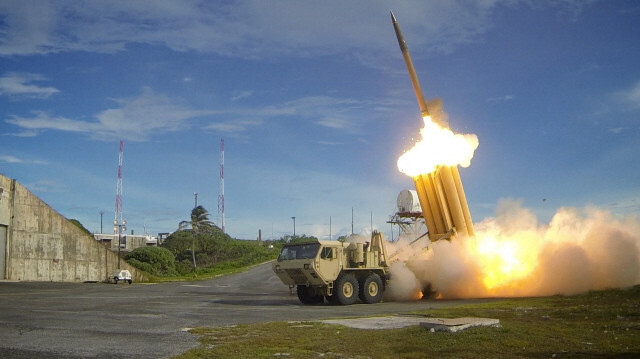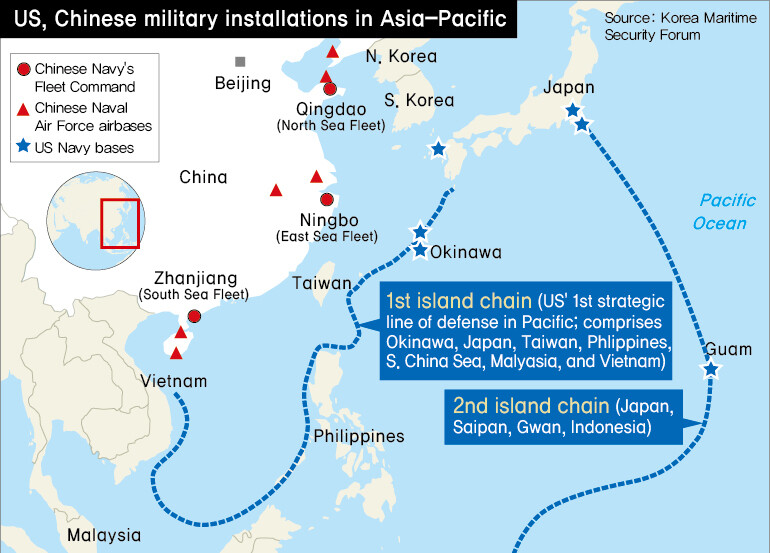hankyoreh
Links to other country sites 다른 나라 사이트 링크
US and China’s hegemonic rivalry bleeds over into military competition

As the US and China crank up their hegemonic rivalry, military confrontation over the Asia-Pacific region is intensifying as well. There are serious concerns that the two countries’ confrontation will force South Korea to make a difficult choice.
As things stand at present, the US holds the advantage, but China is striving to close the gap. Since Xi Jinping came to power, China has been pursuing the “dream of a strong military,” attempting to modernize its army through massive investments and military reforms. China’s defense budget has jumped by an average of 9.42% each year, from 66.9 billion yuan (US$9.41 billion) in 2012 to 104.3 billion yuan (US$14.66 billion) in 2017.

China’s navy and air forces have been growing by leaps and bounds. This past December, China’s navy commissioned the Shandong, its second aircraft carrier and the first built at home. China’s air force has already rolled out the J-20, the country’s first fifth-generation stealth fighter, and it’s rushing forward the development of a sixth-generation fighter. In the area of ballistic missiles, China has improved its precision strike capability with the deployment of the DF-26 and other armaments.
The US is responding with big upgrades to its fighting power. It was recently reported that the US Indo-Pacific Command has requested an additional US$1.6 billion in funding in next year’s defense budget. That funding would provide more long-range precision firepower and an integrated anti-air network to counter the threat of China.
American politicians have also been calling for aggressive action against China’s military makeover. In an op-ed published last month, Republican Senator Jim Inhofe and Democrat Senator Jack Reed argued that the US needs to bolster its key military capabilities to counter China’s growing military clout and the threat it poses.
The problem is that South Korea is likely to face fallout from the military standoff between the US and China. The US strategy of creating a united front against China that adds India to its traditional allies of South Korea, Japan, and Australia leaves South Korea with limited wiggle room. Not long ago, US Secretary of State Mike Pompeo emphasized the need for international cooperation against the military threat of China, mentioning South Korea along with India, Australia, Japan, and the EU.
American intermediate-range missiles are another issue that’s likely to create a headache for South Korea before too long. Last year, the US withdrew from its Intermediate-Range Nuclear Forces Treaty with Russia, which banned the deployment of missiles with a range of 500-5,500km. Since then, the US has indicated it intends to deploy such missiles through deliberations with allies such as South Korea, while China is fiercely opposed to any such missiles being deployed in the region. The missile dispute has the potential to cause serious damage to South Korea, echoing its spat with China over the US’ 2016 deployment of the THAAD missile defense system in Korea.
Park Byong-su, editorial writer
Please direct comments or questions to [english@hani.co.kr]

Editorial・opinion
![[Column] Season 2 of special prosecutor probe may be coming to Korea soon [Column] Season 2 of special prosecutor probe may be coming to Korea soon](https://flexible.img.hani.co.kr/flexible/normal/500/300/imgdb/original/2024/0426/3317141030699447.jpg) [Column] Season 2 of special prosecutor probe may be coming to Korea soon
[Column] Season 2 of special prosecutor probe may be coming to Korea soon![[Column] Park Geun-hye déjà vu in Yoon Suk-yeol [Column] Park Geun-hye déjà vu in Yoon Suk-yeol](https://flexible.img.hani.co.kr/flexible/normal/500/300/imgdb/original/2024/0424/651713945113788.jpg) [Column] Park Geun-hye déjà vu in Yoon Suk-yeol
[Column] Park Geun-hye déjà vu in Yoon Suk-yeol- [Editorial] New weight of N. Korea’s nuclear threats makes dialogue all the more urgent
- [Guest essay] The real reason Korea’s new right wants to dub Rhee a founding father
- [Column] ‘Choson’: Is it time we start referring to N. Korea in its own terms?
- [Editorial] Japan’s rewriting of history with Korea has gone too far
- [Column] The president’s questionable capacity for dialogue
- [Column] Are chaebol firms just pizza pies for families to divvy up as they please?
- [Column] Has Korea, too, crossed the Rubicon on China?
- [Correspondent’s column] In Japan’s alliance with US, echoes of its past alliances with UK
Most viewed articles
- 1[Column] Season 2 of special prosecutor probe may be coming to Korea soon
- 2‘We must say no’: Seoul defense chief on Korean, USFK involvement in hypothetical Taiwan crisis
- 3Is N. Korea threatening to test nukes in response to possible new US-led sanctions body?
- 4Amnesty notes ‘erosion’ of freedom of expression in Korea in annual human rights report
- 5Division commander ordered troops to enter raging flood waters before Marine died, survivor says
- 6N. Korean delegation’s trip to Iran shows how Pyongyang is leveraging ties with Moscow
- 7[Editorial] Korea’s surprise Q1 growth requires objective assessment, not blind fanfare
- 8Is Japan about to snatch control of Line messenger from Korea’s Naver?
- 9No good, very bad game for Korea puts it out of Olympics for first time since 1988
- 10[Reportage] On US campuses, student risk arrest as they call for divestment from Israel